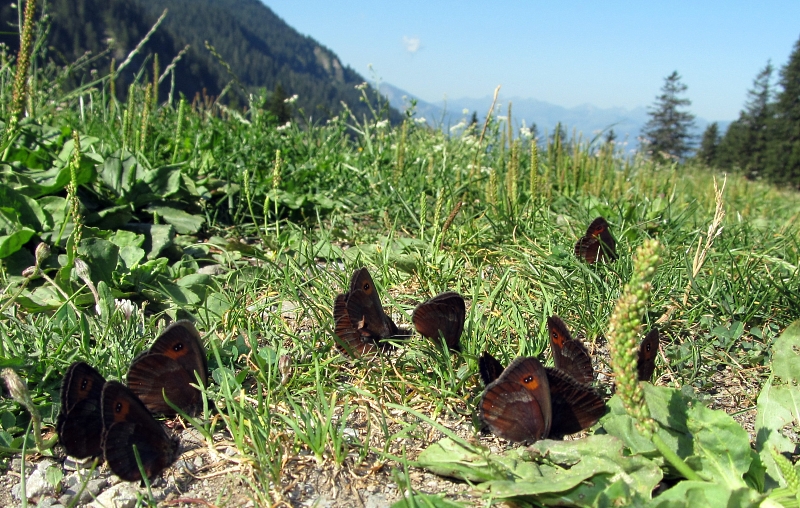just three Swiss species I still have (had) to see. So I got up at 05h00 and set off for Grindelwald - no secret about where I went, as all the books will tell you Grindelwald is the only place in Switzerland this species flies. I've never been there before - my nivalis was not at Grindelwald or one of the other commonly listed places.
It seemed my lucky streak for lifers in 2013 had finally run out when the train from Interlaken to Grindelwald broke down. The driver said it was kaput, he couldn't fix it and he didn't know when, if ever, we might get moving again. My GPS told me we were about four and a half kilometres from Grindelwald so I asked him if I could get out - I can run that easily in half an hour. He said it was 9 km, it would take two hours and I had to stay where I was! But it turned out my luck hadn't run out after all - there must have been another Jonah on the train. By a curious and quite complex twist, I was soon driving to Grindelwald with a very kind Japanese lady, who had stopped to find a colleague and ended up with me instead. I don't really understand what happened, because it was in Swiss German, French and English - and maybe a little Japanese - but the colleague stayed on the train (he rang her while we were driving) and I found my first sudetica at 10h15!
First, the usual safety shot, in the shade, to secure the record:

Things to look out for in sudetica include the dark spot in the foremost red patch of the forewing and the evenly sized hindwing red spots, all of which include a dark centre, even if this is often vestigial.
None of my pictures of this species came out terribly well - mainly because they moved incessantly while nectaring - but I got a few looking slightly more natural, at least, and will know where to come back next year!

This is a different individual, with much less prominent spotting:

Here is a third sudetica:

This one was crawling all over my net but I hadn't netted it - it was just drawn to the smell of me:

It also enjoyed my backpack:

I watched a gravid female deep down in the grass but couldn't photograph her without interfering - I didn't see her lay.
Many of the areas I had hoped to explore were being mown, or had been mown, and if I had come a day or two later I might have drawn a blank.

I didn't photograph much else, but here is a rather lovely and very distinctive female manto ringlet:

My second name is Lawrence, after the former Governor of India (or maybe after Henry Montgomery Lawrence, who founded the Lawrence School in India, where my great grandfather was headmaster - I'll have to ask my Dad which). I hope future generations will remember me as Lawrence of Erebia!

(self portrait with the iPhone!)
Having found a good number of sudetica quickly, I decided to explore the unmown meadows at slightly lower altitudes but found nothing. Looking back up the mountain, I realised I had started my search at probably the only place where they were still common: lower down they were over, if they ever flew there, and up there most of the meadows had been mown.
Other butterflies flying included Erebia aethiops, euryale, oeme, pharte and epiphron, tit frit, high-brown frit, silver-washed frit, false heath frit, purple-edged copper, sooty copper, small heath, alpine heath, large skipper, small skipper, Essex skipper, large wall, meadow brown, black-veined white, Berger's pale clouded yellow, swallowtail, common blue, Adonis blue, and chalkhill blue. I needed to get back rather quickly so didn't hang around enjoying everything. Tomorrow morning is another 05h00 rise, this time for yellow-banded ringlet, Erebia flavofasciata.
Guy




















































































